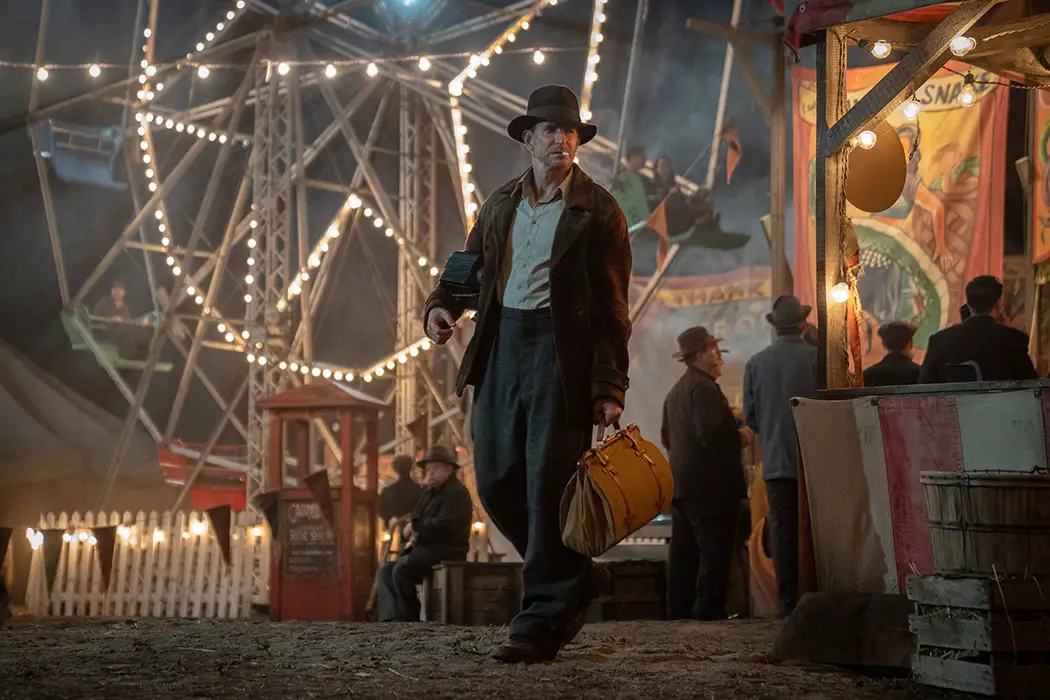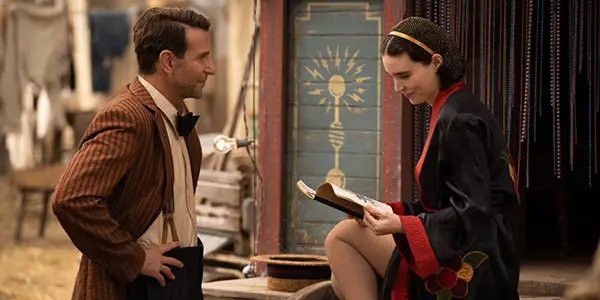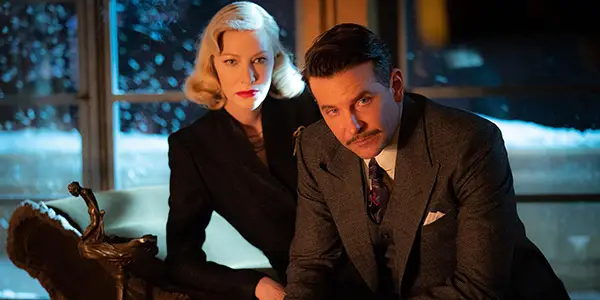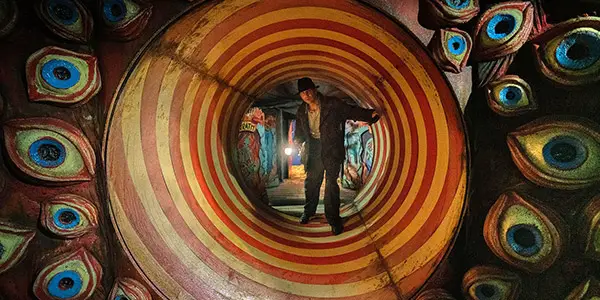NIGHTMARE ALLEY: An Average Thriller From a Masterful Storyteller

David is a film aficionado from Colchester, Connecticut. He enjoys…
I have been a big fan of Guillermo del Toro for many years. It mostly started after seeing his masterpiece Pan’s Labyrinth, and since then, I have journeyed through his filmography several times over, enjoying the wide range of stories he has blessed us with. But, as with most filmmakers, there are some that don’t stand out; in fact, they may stick out more because they don’t fit in neatly with the rest. Nightmare Alley is one of those movies.
If anyone but Guillermo del Toro was directing it, I would think of it as just a standard, run-of-the-mill modern noir. But with del Toro behind the helm, my standards are typically higher. And while Nightmare Alley does have its strong points – casting, performances, production design, score, etc. – it mostly fades into the background noise of a master behind the camera.
The Noir
Nightmare Alley is about a man named Stanton “Stan” Carlisle (Bradley Cooper). Down and out on his luck (after a mysterious opening involving a fire that we will get back to later on), he finds himself in a circus. He is immediately enraptured and enthralled by the various performers, which includes ringmaster Clem Hoately (Willem Dafoe), mystic Zeena Krumbein (Toni Collette), her older typically-drunk husband Pete (David Strathairn), electric-infused Molly Cahill (Rooney Mara), strong man Bruno (Ron Perlman), the short man with a booming voice Major Mosquito (Mark Povinelli), and a wild, disheveled beast/man known as the Geek (Paul Anderson). Clem takes a liking to Stan, as do both Zeena and Pete, who immediately take him in.

Stan quickly becomes adapted to the circus life, and after some time, he also finds that he has a natural gift for reading people, leading him to think he can become a sort of mystic like Zeena. He also learns of a secret “code” where at a live show two performers can communicate with one another without the audience knowing. Pete warns him not to go down this road, as it could lead to his downfall. Shortly after a tragedy, though, Stan decides to set off on his own, taking along the young Molly with him. What follows will, as predicted, take Stan down a dark and twisted path, which also leads him to Lilith Ritter (Cate Blanchett) and the rich elderly man Ezra Grindle (Richard Jenkins).
Nightmare Alley is based on the novel by William Lindsay Gresham, and had actually been filmed once before back in the 1940s when noir was at its peak. Having recently seen this adaptation, it was interesting to compare and contrast the two filmmakers’ approaches. Some noir from the ’40s might occasionally be off-putting with modern audiences; everything is different, from the aspect ratios to the style of acting to the production designs. But I found this one in particular incredibly alluring, as it takes us into the world of a charismatic man who just gets in over his head.
The Modern Approach
In del Toro‘s version, there are significant changes made. For one, the principle character, though aptly played by the usually-reliable Bradley Cooper, is not nearly as likable. He’s not meant to be seen as someone to idolize, but at the same time should have been more sympathetic, in a way almost believing his lies are justified and not realizing the harm they are doing. Throughout Nightmare Alley, I outright hated Cooper‘s Stan, which made me unattached and uncaring about his journey and eventual plight. And I believe this is just one of several flaws in del Toro‘s adaptation.
Perhaps the most glaring issue with the film is that, just as in the portrayal of Stan, the story doesn’t trust and have faith in its audience. Certain scenes and dialogue are stretched out beyond what is necessary, not only leading to the film’s extended 2.5-hour length, but also halting its pacing and momentum along the way. Though I love seeing great actors like Cooper and Blanchett engaged in fiery back-and-forth dialogue, and indeed these are some of the film’s highlights, but such scenes, when extended as they are, instead say much more than they needed to.

This didn’t need to be a straight, by-the-books adaptation of the story, and indeed, the 1940s version knew that. In that film, the use of subtlety and foreshadowing leads to some of its grander impact by the end. In this adaptation, we see obvious hints thrown at us from the start as to what is transpiring, with the screenplay holding our hand through the character arc and transformation of Stan. It doesn’t trust us to draw our own conclusions from what we see on screen, and that leaves the audience with little to think about once the credits roll.
The most representative moment of this is during one scene involving Mary Steenburgen‘s Miss Kimball, which I obviously can’t get into for spoiler reasons. Suffice to say, the scene results in an overtly obvious ramming home of the themes of Nightmare Alley. And especially considering what else is going on at the time, it’s entirely superfluous and a waste of extra screen-time.
Positive Elements
Rather than be all negative, though, there are still some attributes of del Toro‘s film to admire. For one, del Toro shows his typically expert use of cinematography and lighting, here using his usual collaborator Dan Laustsen. The Director of Photography shoots the film with multiple uses of shadows and muted tones, similar to how a noir would have been shot back in the day. There are also some lavish production designs, especially some of the eerie visuals of the initial circus scenes, which hearkens back to del Toro‘s typical love of the macabre. And the score by Nathan Johnson, though not as memorable as those in del Toro‘s past films such as Alexandre Desplat‘s in The Shape of Water, still manages to energize the film, especially during some of the riveting back-and-forth dialogue.

And one would be remiss to not mention the cast of Nightmare Alley, which is basically a listing of great actors signed up for the same film. Besides the aforementioned Cooper and Blanchett, you also have Willem Dafoe, Toni Collette, Rooney Mara, Richard Jenkins, Ron Perlman, Holt McCallany, and more; even Tim Blake Nelson shows up at one point. Basically, it would be difficult to put that much talent into one movie and at least not have some memorable exchanges, and on this aspect, Nightmare Alley delivers. Kudos to the casting agent in particular for the film.
Not Your Typical Del Toro Film
One of the reasons that del Toro‘s Nightmare Alley doesn’t seem as groundbreaking as many of his films is because of what he has accomplished previously. The dark romantic fairy tale The Shape of Water, for example, won a bunch of Academy Awards upon its release, including Best Picture and Best Director. And in the past, he has done films as wide-ranging as ghost stories (Crimson Peak, The Devil’s Backbone), vampire films (Cronos, Blade II), and even more audience-friendly action blockbusters like the original two Hellboy films.
What seems to bind them all together, though, is del Toro‘s use of monsters. They’re seen as metaphors for good, for evil, for love, for misunderstanding; whatever the story requires. But in Nightmare Alley, that’s sorely lacking. We see an attempt to make the human characters the monsters instead, but this doesn’t work as well because, as mentioned, it’s made too obvious that this is the case, rendering the metaphor moot.
Conclusion
At any rate, while I admire del Toro‘s attempts to step away from the genre he has been known for, Nightmare Alley still comes up short. It’s a tense thriller that will be sure to please audiences if they can get past the film’s extended length, but it still had more potential to be something greater. Still, as always, I remain a committed del Toro fan, and I eagerly await his next film.
What are your thoughts on Nightmare Alley? Are you a fan of Guillermo del Toro’s work? Let us know in the comments below!
Watch Nightmare Alley
Does content like this matter to you?
Become a Member and support film journalism. Unlock access to all of Film Inquiry`s great articles. Join a community of like-minded readers who are passionate about cinema - get access to our private members Network, give back to independent filmmakers, and more.
David is a film aficionado from Colchester, Connecticut. He enjoys writing, reading, analyzing, and of course, watching movies. His favorite genres are westerns, crime dramas, horror, and sci-fis. He also enjoys binge-watching TV shows on Netflix.













